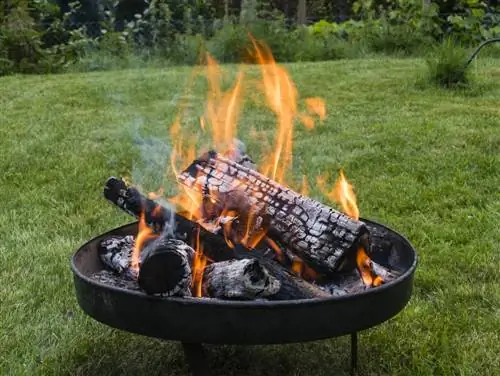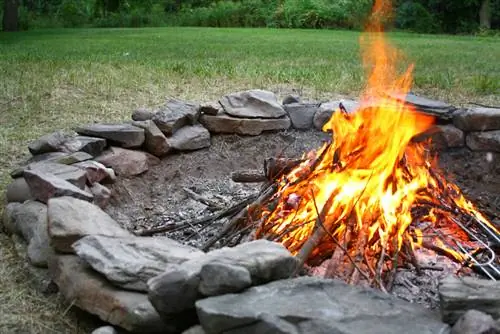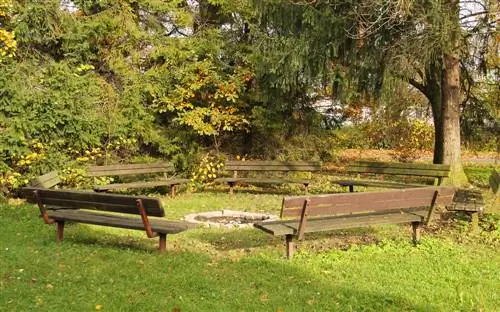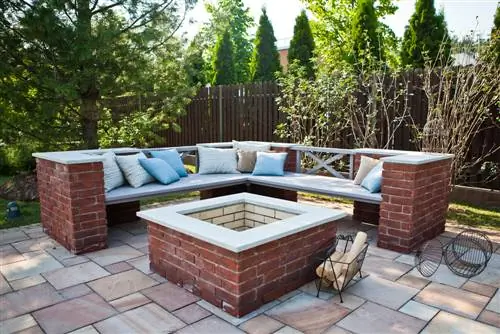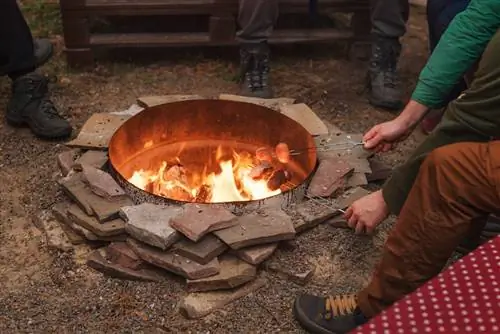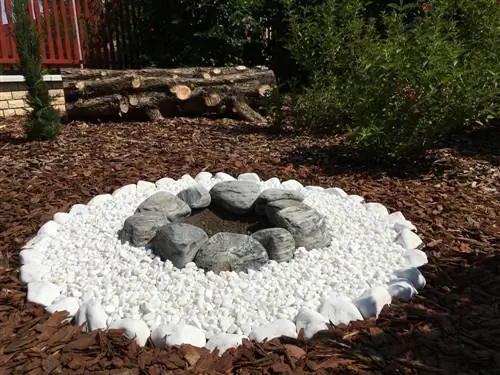- Author admin [email protected].
- Public 2023-12-16 16:46.
- Last modified 2025-01-23 11:21.
Crackling, flickering fire creates campfire romance not only in summer: people have enjoyed gathering around an open fire since ancient times, as it promises warmth and protection. That's why a campfire not only brightens up warm summer nights, but also extends the gardening and grilling season by a few weeks. After all, it is still easy to survive in front of such a heat source in late autumn or early spring.
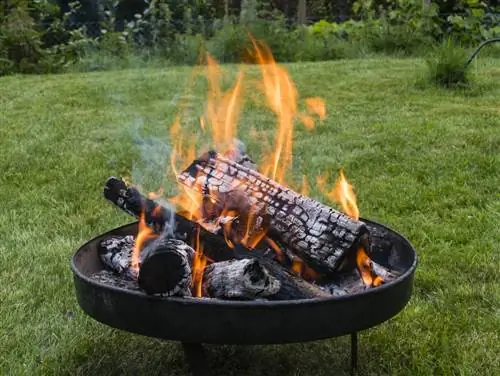
How do you design a fire pit in the garden?
Fire pits for the garden can be permanently installed or mobile and made of different materials such as stones, metal or ceramic. It is important to use dry and untreated wood and to follow safety rules in order not to endanger the surrounding area and neighbors.
Take a look at the municipal regulations before construction
However, building a fireplace is not always allowed. Especially before building a permanent fireplace, for example a brick one, you should first take a look at the municipal regulations or ask the responsible building authority - especially if you have neighbors in the immediate vicinity. Anyone who owns an allotment garden, however, should first take a close look at the lease agreement or the allotment garden regulations of their association: many allotment garden associations prohibit the construction of a fireplace, usually due to the immediate proximity to the neighbors. They could feel disturbed by the smoke.
What you need to pay attention to when burning wood in the garden
There are also certain rules that you need to follow when burning wood in the garden. These serve your own safety - after all, an open fire, no matter how romantic it may be, always represents a security risk - as well as maintaining the peace in the neighborhood.
What not to do when burning wood in the fireplace
Under no circumstances should you burn wet and/or fresh wood. This creates a lot of smoke, which in turn bothers the neighbors and can also get you in a lot of trouble with the local fire department. In most municipal regulations, burning such wood is prohibited or limited to certain months of the year (for example from March 1st to March 31st). Further rules for burning wood in your own garden are:
- no fire in strong winds: Sparks can be blown away here, which can set neighboring houses on fire.
- Do not burn plywood or other treated wood (e.g. varnished, painted or tar-treated wood): formation of toxic gases
- No use of gasoline or other fire accelerants: risk of injury!
- Wood from the forest may only be cut or collected with the permission of the forester or the municipality
How to do it right
- burn only well-seasoned, dried and untreated wood
- Suitable types of wood: logs, briquettes, dry twigs and brushwood, dry cones, dry branches or even individual tree trunks (so-called Swedish fire)
- Always stack the wood directly before lighting: hedgehogs and other small animals like to hide in it, which you would then burn with them.
- Make sure the location is safe: make the surface fireproof with sand and stones
- no combustible materials, trees or wooden huts/houses within 50 meters
- an equally large safety distance from neighbors must also be maintained
- Never leave fire burning unattended!
- Have extinguishing media (e.g. a bucket of water or a box of sand) ready.
- Extinguish the fire completely when leaving - do not leave any embers behind!
What types of fire pits are suitable for the garden?
When it comes to fire pits, there are many different design options: small or large, brick or mobile fire basket, made of ceramic, used bricks or other stones, made of metal, glass or as an upcycling project with materials such as old car tires or rims. We have summarized a few ideas for you in the following table:
| Fixed installation / mobile | Fire pit type | Suitable materials | Advantages | What needs to be considered |
|---|---|---|---|---|
| permanently installed | bricked | various stones: quarry stones, fireclay, bricks, paving stones, granite, clinker | free design of the fire pit, matching the garden design | only use fireproof stones: otherwise they will shatter in the heat |
| permanently installed | Garden oven, brick grill with fireplace | various stones | Multi-purpose use possible, available commercially as a kit | Observe building regulations, pay attention to fireproof materials when building your own |
| permanently installed | open campfire | wind-protected, open area in large gardens | Campfire romance, quickly set up | Prepare the ground to make it fireproof, build a stone boundary |
| mobile | Swedenfire | slit tree trunk or wooden block, at least 50 centimeters in diameter | natural variant of a fire bowl | Use softwood, dispose of cooled leftovers in organic waste |
| mobile | Fire bowls or baskets | Metal, ceramic, sometimes glass | Can be set up individually, usually no approval required | Only set up on suitable, fireproof surfaces, never on grass |
| fixed installation / mobile | gas fireplace | Metal or glass | Fire at the push of a button, without wood | Table fireplaces are not suitable for grilling |
Fixed fireplaces
Brick fire pits in the garden can be designed in very different ways: for example, made of fine natural stone or fireproof, old bricks. You can either plan such a place on the ground and place seating around it, or you can embed the fire pit in a depression in the ground. In this case, steps can be built around the fire, which can also serve as seating.
Mobile fire pits
Fire baskets or bowls generally do not require official approval, but like fixed fire pits, they must be set up on a safe surface. This is especially true if they are open at the sides or at the bottom, allowing embers to escape. Stone surfaces are best suited (€51.00 at Amazon).
Tip
Many commercially available fire baskets or bowls can also be converted into grills by simply placing a suitable grate on them.

